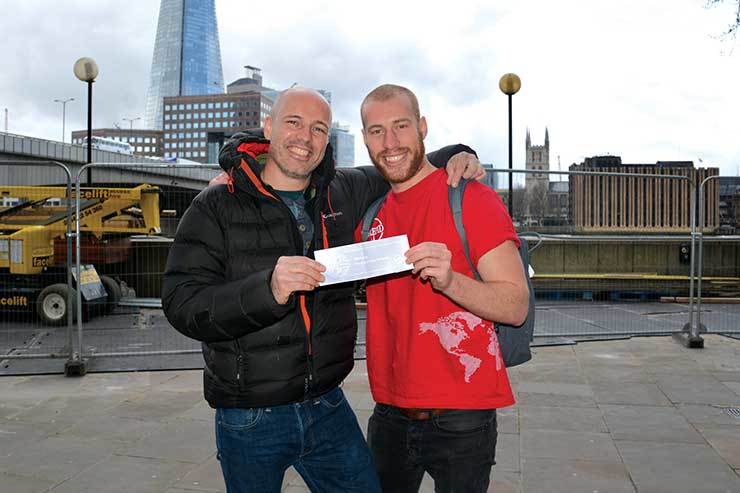How travel helped get Nepal back on track
 Sophie Griffiths
Sophie GriffithsApril 25 marked the one-year anniversary of the Nepal earthquake. Sophie Griffiths looks at how travel firms helped the country get back on its feet, and Katherine Lawrey explains why tourists should return.
Pictured: Pat Driscroll (left) and Intrepid’s Tom Smith
Two weeks ago construction worker Pat Driscoll was busy working on a project in the tunnels of London Bridge, when he was surprised by Intrepid marketing executive Tom Smith, who presented him with a trip to Nepal.
Driscoll was one of many former Intrepid travellers to Nepal who had helped raise funds (£1,300 in his case) for the relief effort in the wake of last year’s devastating earthquake, which left more than 8,000 dead and destroyed more than half a million homes. He was also one of three donors to be randomly selected by Intrepid to fly to Nepal’s remote Tamang region – an area hit particularly hard by the quake – to see first-hand where their donations went.
Along with the help of its customers, Intrepid raised a total of £350,000. It was just one of many travel firms which rushed to help in the relief effort. G Adventures also raised more than £100,000, and awarded 154 homegrants, each worth around £250 – £750.
There were also individual members of the industry who contributed to the effort, including Celebrity Cruises’ head of business development Michael English, who first visited Nepal when he trekked to Everest Base Camp in December 2014. He had been due to return in May last year, but then the quake struck. English was so moved by the devastation it caused, that he decided to visit anyway and donate his time in helping the people.
“We wanted to do our bit in helping the local communities that we had met on our first trip – the people are just so incredible,” he told TTG.
“We were in the air when the second quake struck. We were diverted, and it was three days before we were able to reach Kathmandu. And it was chaos everywhere – we couldn’t do much, so we just went to the village of our guide and tried to help in tidying everything up and moving bricks.”
Steady recovery
With all the negative headlines and images depicting the devastation, it is little surprise that tourism to Nepal was significantly down for the 2015-16 season.
“We were well below where we should have been, with visitor numbers falling around 30%,” admits Geoff Manchester, co-founder of Intrepid.
“Once you have a natural disaster like this, people tend to write off the region for a couple of years. But we’ve really pushed Nepal to show the world that it is ready for travellers.”
The message seems to be getting through. “Bookings for next season [September 2016 – March 2017] are up on where we would have been before the earthquake, with more visitors set to visit Nepal than in the last 10 years,” Manchester reveals.
The UK is proving particularly strong – Intrepid has seen a 20% rise in bookings compared with the previous year.
G Adventures has seen a similar increase. The operator is predicting 69% growth in Nepal for 2016, and while it acknowledges that this number is global, it notes that the biggest passenger numbers are coming from the UK and Australia.
Michael English is equally keen to return to the country, and has already planned a trip for next April. “I would say to anyone – 100% you should go there,” he adds. “The people, the destination – they’re just so incredible. If someone wants to give something back – visit Nepal. It’s times like this that tourism should be helping.”
One year on
By Katherine Lawrey in Kathmandu, Nepal
The lights went out first, and then I felt it. A definite shake of the ground I was stood on.
For the Kathmandu shopkeeper who was showing me cashmere scarves, it was an unwelcome reminder of the devastating quake that rocked Nepal nearly a year before. His father though was more concerned about losing the sale and moved to reassure me. Outside, life carried on as normal.
The brief tremor was nothing compared with the earthquake of April 25, 2015, which shattered lives and destroyed homes.
The full impact hit me in Durbar Square. There are gaping holes where stupas once stood, and historic landmarks are propped up by scaffolding, rubble spilling out like an open wound.
Everyone had their story of where they were when the quake hit, and some were heartbreaking.
Along the trekking route from Lukla to Namche Bazaar, my experience was not impacted by the earthquake. I walked over one make-shift bridge, and a few guesthouses bore large cracks and were closed for business.
But there was reconstruction and optimism.
In less-visited areas, though, the recovery has stagnated and people still live in makeshift homes. Tourism – a lifeline for the economy – dropped by more than half in the last year. Now is not the time to turn our backs on Nepal. |
Sign up for weekday travel news and analysis straight to your inbox

Sophie Griffiths
Supplier Directory
Find contacts for 260+ travel suppliers. Type name, company or destination.















